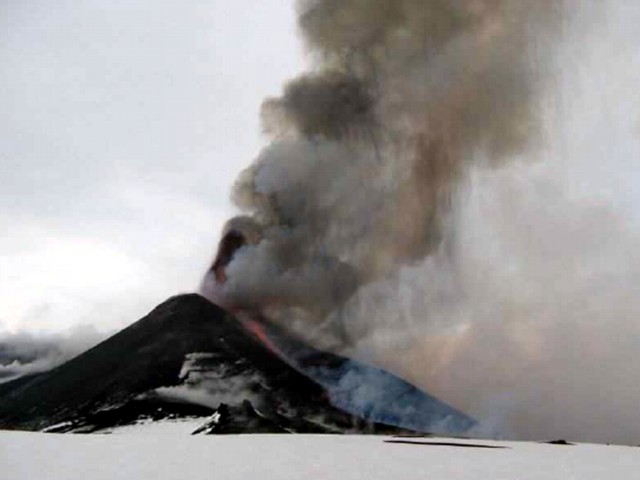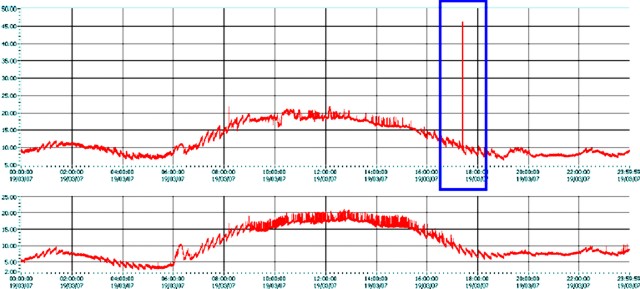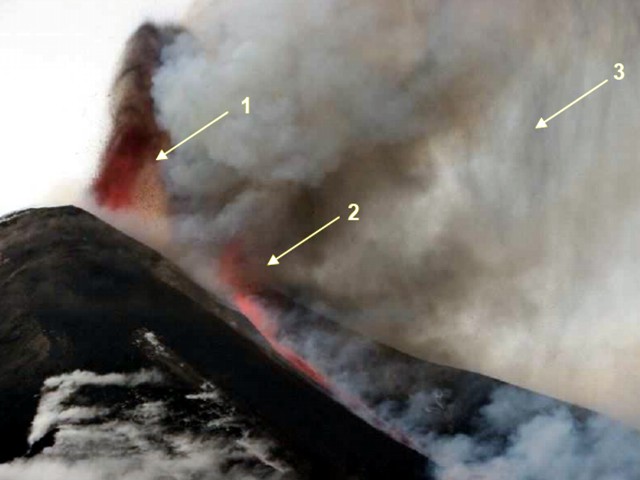Report on Etna (Italy) — March 2007
Bulletin of the Global Volcanism Network, vol. 32, no. 3 (March 2007)
Managing Editor: Richard Wunderman.
Etna (Italy) Eruptions continue in April 2007
Please cite this report as:
Global Volcanism Program, 2007. Report on Etna (Italy) (Wunderman, R., ed.). Bulletin of the Global Volcanism Network, 32:3. Smithsonian Institution. https://doi.org/10.5479/si.GVP.BGVN200703-211060
Etna
Italy
37.748°N, 14.999°E; summit elev. 3357 m
All times are local (unless otherwise noted)
Recent eruptive episodes occurred between 4 November and 14 December 2006, with small eruptions on 19 and 29 March 2007 (BGVN 32:02). According to the Istituto Nazionale di Geofisica e Vulcanologia Sezione di Catania (INGV), there were other noteworthy eruptions on 11 and 29 April 2007.
The eruption of 19 March was captured on video as well as a thermal monitoring system. The thermal data appear on figure 120, which also includes data from a reference site away from the eruption (lower panel). Both sites underwent similar diurnal variations due to solar warming and night-cooling effects. The 19 April 2007 eruption appears as a 37°C upward spike in apparent temperature (computed from the sensor system).
The INGV reported that the 29 March eruption took place at Bocca Nuova. Two new lava streams emerged near the summit, one at 3,180 m elevation, and the other at 3,050 m elevation. The lava flows advanced initially but ultimately halted after related emissions only lasted several hours (ceasing at 1500 local time).
INGV's report on the 11 April event noted an increase in volcanic tremor, followed by lava fountaining. That eruption lasted about 5 hours. A resultant ash plume drifted E with ashfall reported as far as Zafferana, about 10 km E. Two lava flows were observed at the summit of Etna, one to the E within the large depression on the side of the volcano known as the Valle del Bove and the second to the S. The E lava flow stopped 3 km away at the base of the Serra Giannicola Grande, within the W Valle del Bove. The second flow stopped near Mt. Frumento Supino (less than 1 km S of the summit).
A new summit eruption began on 29 April 2007 with a general increase in tremor followed by fire fountaining and a vertical ash cloud. The INGV-CT monitoring webcams showed the evolution of this eruptive phase that lasted about 8-9 hours. At 1600 the thermal webcam at Nicolosi registered a thermal anomaly at the Southeast Crater (SEC); there were also reports of rumbling from the summit craters. At 1834, explosions of lapilli and ash were observed almost continuously, together with lava emission very near the explosive vent (figures 121 and 122). A lava flow followed the fissure on the SE flank of the SEC, which had opened during November 2006. Another flow moved E within the Valle del Bove.
 |
Figure 121. Activity at Etna's Southeast Crater at 1834 on 29 April 2007, seen from the S at Torre del Filosofo. Courtesy of INGV. |
Geological Summary. Mount Etna, towering above Catania on the island of Sicily, has one of the world's longest documented records of volcanism, dating back to 1500 BCE. Historical lava flows of basaltic composition cover much of the surface of this massive volcano, whose edifice is the highest and most voluminous in Italy. The Mongibello stratovolcano, truncated by several small calderas, was constructed during the late Pleistocene and Holocene over an older shield volcano. The most prominent morphological feature of Etna is the Valle del Bove, a 5 x 10 km caldera open to the east. Two styles of eruptive activity typically occur, sometimes simultaneously. Persistent explosive eruptions, sometimes with minor lava emissions, take place from one or more summit craters. Flank vents, typically with higher effusion rates, are less frequently active and originate from fissures that open progressively downward from near the summit (usually accompanied by Strombolian eruptions at the upper end). Cinder cones are commonly constructed over the vents of lower-flank lava flows. Lava flows extend to the foot of the volcano on all sides and have reached the sea over a broad area on the SE flank.
Information Contacts: Sonia Calvari, Istituto Nazionale di Geofisica e Vulcanologia, Sezione di Catania, Piazza Roma 2, 95123 Catania, Italy (URL: http://www.ct.ingv.it/).



